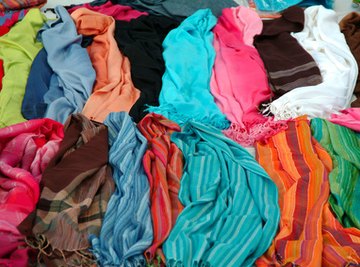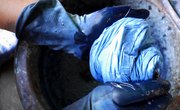
If you've ever worn a raincoat that got soaking wet in the rain, you may have wondered whether its manufacturers ever studied fabric absorbency. For your science fair experiment, you may want to consider comparing the absorbency of various fabrics, such as cotton, wool, plastic, and synthetic materials.
The Basic Experiment
The most basic experiment requires the use of a graduated cylinder. A graduated cylinder is similar to a measuring cup, but usually taller, thinner, and much more precise. Simply cut several fabrics into the same size and shape, and then place each one into a different graduated cylinder filled about halfway with water. (Make sure that you know the exact volume of the water before you place the fabric in.) Let each fabric soak for ten to twenty seconds so that it absorbs as much water as possible. Then carefully remove the fabrics with a pair of tweezers, making sure to squeeze out as little water as possible in the process.
To find out how much water each fabric absorbed, simply subtract the volume of water at the end of the process from its volume at the beginning. Compare the volume of water that each fabric absorbed to figure out which is the most absorbent.
Different Weaves of Fabric
After you have tried the previous experiment using completely different fabrics, you may want to look into different weaves of the same type of fabric. You can use several different thread counts as well. You may also want to look into the absorbency of several different cloth diaper brands or of several towels that are made from the same material, but by a different company. Use your imagination to come up with other variations on the basic experiment.
Paper Products
A slightly different way to approach this experiment would be to focus on the differences between several different types of paper products, such as paper towels, tissues, and toilet paper. One of the most practical experiments on this topic compares several different brands of paper towels (or several different brands of another paper product). You can prove advertising slogans correct or incorrect based on this experiment, especially if one product advertises itself as being more absorbent than the others.
References
About the Author
Keren (Carrie) Perles is a freelance writer with professional experience in publishing since 2004. Perles has written, edited and developed curriculum for educational publishers. She writes online articles about various topics, mostly about education or parenting, and has been a mother, teacher and tutor for various ages. Perles holds a Bachelor of Arts in English communications from the University of Maryland, Baltimore County.
Photo Credits
colorful fabrics image by JoLin from Fotolia.com
